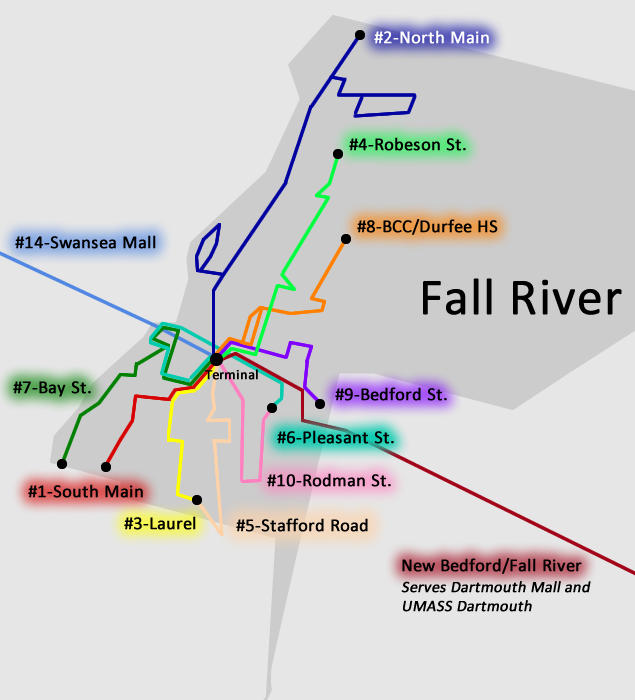I'm not as worried about a local bus connection to the FR Depot station. I have a bunch of relatives in FR who's family has been there all the way back when they built the first cotton mills. A couple of high school friends lived there too and out of 30 people or so I don't ever remember anybody taking so much as one local bus ride. It's a car culture, so as long as there's ample parking this shouldn't affect ridership too much.
No...you actually pretty much state point-blank the reason why it's going to badly underperform and be an explicit worry. It's a car culture. It is NOT plug-ready with the bus network. The parking fee for such anemic frequencies is itself prohibitive...therefore the fact that it lacks connectivity to the cheaper bus fares IS a grave inhibitor to showing any kind of pulse. Out-of-box SRTA integration is the only thing giving New Bedford's two stations a pulse to build upon while the frequencies are so useless, because it's more mobility for a lower cost given what they have to work with. Fall River not even beginning to troubleshoot the integration problem depresses the ridership even further. Look at the SRTA spider map.

Odd distribution, no? The Terminal is City Hall Plaza. Most of the routes are fairly short and clustered. That's because, as a city of hills, Fall River's transit shares are much higher where the geography poses mobility challenges...much lower where it doesn't. So...caution!...one family's personal transit-use tale does not speak for the city as a whole when geography creates a wholly natural skew in where the city's highest transit shares live.
The #2 up North Main is the only route in the city that touches Fall River Depot train station, at about the halfway point between City Hall Terminal and the Bicentennial Park loop. Most of the 2 is duplicated by the MA 79 eyesore and the highway-ruined neighborhood along Davol St. Higher car shares, which is why it's such a "one of these is not like the other" at being long, stingy, and broken up by distended looping...lots of chores en route for relatively low ridership.
^This^ is way too much to be leaving off the table functionally shut out from the train, if they ever want it to show a pulse. The only route that can get easily to the train is one that needs it least, and runs longest so is harder to transfer to. The other ones that already serve higher transit shares because of endemic mobility challenges in the areas they serve...are the ones facing the biggest mobility challenge to ever reaching the train station in the first place. And it is not a safe assumption that the transit density on those highest-demand routes are simply going to get in their cars and pay a much higher parking rate at FR Depot as if that's no big deal. How many times did the T build parking sinks relocated away from traditional multimodal-accessible downtown stops because conventional wisdom said exactly that...and then everyone was kerfuzzled when ridership underperformed? Fall River isn't the exception to that rule. It's already got a tightly-wound bus network with a number of routes delivering decently high transit shares. You can't simply ignore that and wave it away as if Pn'R's are going to save the day.
What they need is a bit of that street-circulator duplication that the #1/3/7 follow down by the boulevarded 79/138/195 interchange and the port before divering on their merry ways...put punched north up a Phase II MA 79 teardown that makes lower Davol more functional for the same purpose. It's not going to be an elegant-looking loop, because the train station going at the same location it always was dating back 150+ years while City Hall Loop was a post- Urban Renewal creation of the 195 Downtown canyon...and thus RR and surface transit aren't aligned as close as they were 60 years ago. But you have to at least shoot for a matching 'elbow' that 3 or more routes can glom onto hitting the train station before dispersing, or there's simply no way to link existing transit shares with the new mode. Foregoing that elbow grease does not mean cars are going to flock to the Pn'R lot to overpay for shit frequencies. It means those transit shares never meet the train...ever.
When it comes time for New Bedford to start beating down MassDOT's door for more frequencies, it can point to its SRTA integration for the latent demand that would be served. Fall River can't, because it hasn't made the faintest attempt to try. So given all we know about what a precarious position the prospects of more frequencies
period is sitting on with this brittle Phase I and wittheld promises of a Phase II follow-up...which city do you think is going to be able to pry any more frequencies if they happen to come available? They sure as hell aren't going to be apportioned equally when one is trying to better its multimodal coattails and one couldn't possibly give less a crap. The service disparity widens from here.
Maybe for somebody's family in some neighborhood that's no big deal...but don't try to spin that to the whole city. Quite a lot of them are existing transit riders shaking their head at the utter senselessness of this willful non-integration.

